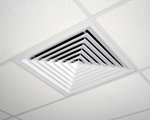On a recent trip to India, I discovered a cute clothing sizing term called “free size” which is equivalent to “one size fits all”. Free size clothing must be a manufacturer’s delight since production and distribution are greatly simplified. Adjustments to the size of the garment are typically made through waist ties of various designs and if needed, permanent alterations.
In the A/E/C industry, diffuser, grille and register (air device) manufacturers have chosen the free size philosophy when it comes to providing sound data. Instead of supplying sound power data for air device models, which can be used in an analysis for any situation, Noise Criteria (NC) values are provided. This is understandable, since publication of sound power data would greatly increase the number of pages in the catalog.
While NC is a convenient single number sound rating, some assumptions are made in its calculation. These assumptions are necessary to convert the tested sound power to the sound pressure required to generate an NC rating. The assumptions center on the characteristics of the receiving room, such as the room size, amount of sound absorption present, distance from the device to the listener and number of diffusers in close proximity to the listener. A standard conversion must be used, and 10 dB was selected as an average value. That may fit the situation perfectly, or it may not.
One case where a 10 dB conversion factor applies is for a room with a 9 ft ceiling height and 550 sf of floor area (Schultz, 1985). For smaller rooms, the conversion factor will be smaller, resulting in the room sound level being higher. Conversely, for larger and more absorptive rooms where the diffuser is further away, the conversion factor is higher and the sound levels lower. However, multiple diffusers add sound, negating to an extent the benefit of a larger room.
Sound power data may be available from the manufacturers, but I’d venture a guess that it is rarely requested. Approximations in adjusting the manufacturer’s rating can be made for small rooms using the following table (adapted from Application of Manufacturers’ Sound Data by Ebbing and Blazier, ASHRAE 1998).
|
Approx. |
No. of |
Approx. adjustment to mfg. NC data (dB) |
|
125 |
1 |
+4 |
|
300 |
1 |
+2 |
|
300 |
2 |
+5 |
For an open plan office with four or more diffusers, the following approximate adjustments can be made.
|
Diffuser array spacing (ft) |
Floor area per |
Approx. adjustment to mfg. NC data (dB) |
|
10 x 10 |
100 |
+6 |
|
12 x 12 |
150 |
+5 |
|
15 x15 |
250 |
+4 |
|
20 x 20 |
400 |
+3 |
Of course, there are an infinite number of situations and that’s why sound power data (applicable to all analyses) are preferable to NC ratings for air devices. For now, that’s not the world we live in and it’s up to the designer to seek help from qualified indepedent acoustical consultants like Acoustics By Design, or to know how to adjust these “free size” NC ratings to suit the specific situation. Unlike my universal dress size discovery in India, all diffuser noise levels are not created equal. Buyer beware!
